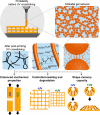Application of Shape Memory and Self-Healable Polymers/Composites in the Biomedical Field: A Review
- PMID: 37720748
- PMCID: PMC10500588
- DOI: 10.1021/acsomega.3c04569
Application of Shape Memory and Self-Healable Polymers/Composites in the Biomedical Field: A Review
Abstract
Shape memory-assisted self-healing polymers have drawn attention over the past few years owing to their interdisciplinary and wide range of applications. Self-healing and shape memory are two approaches used to improve the applicability of polymers in the biomedical field. Combining both these approaches in a polymer composite opens new possibilities for its use in biomedical applications, such as the "close then heal" concept, which uses the shape memory capabilities of polymers to bring injured sections together to promote autonomous healing. This review focuses on using shape memory-assisted self-healing approaches along with their respective affecting factors for biomedical applications such as tissue engineering, drug delivery, biomaterial-inks, and 4D printed scaffolds, soft actuators, wearable electronics, etc. In addition, quantification of self-healing and shape memory efficiency is also discussed. The challenges and prospects of these polymers for biomedical applications have been summarized.
© 2023 The Authors. Published by American Chemical Society.
Conflict of interest statement
The authors declare no competing financial interest.
Figures








References
-
- Greco F.; Mattoli V. Introduction to active smart materials for biomedical applications. Piezoelectric Nanomaterials for Biomedical Applications 2012, 1–27. 10.1007/978-3-642-28044-3_1. - DOI
-
- Zhang Y.; Liao J.; Wang T.; Sun W.; Tong Z. Polyampholyte hydrogels with pH modulated shape memory and spontaneous actuation. Adv. Funct. Mater. 2018, 28 (18), 170724510.1002/adfm.201707245. - DOI
-
- Li C.; Jiao Y.; Lv X.; Wu S.; Chen C.; Zhang Y.; Li J.; Hu Y.; Wu D.; Chu J. J. A. a. m.; et al. In situ reversible tuning from pinned to roll-down superhydrophobic states on a thermal-responsive shape memory polymer by a silver nanowire film 2020, 12 (11), 13464–13472. 10.1021/acsami.9b20223. - DOI - PubMed
Publication types
LinkOut - more resources
Full Text Sources
Miscellaneous

